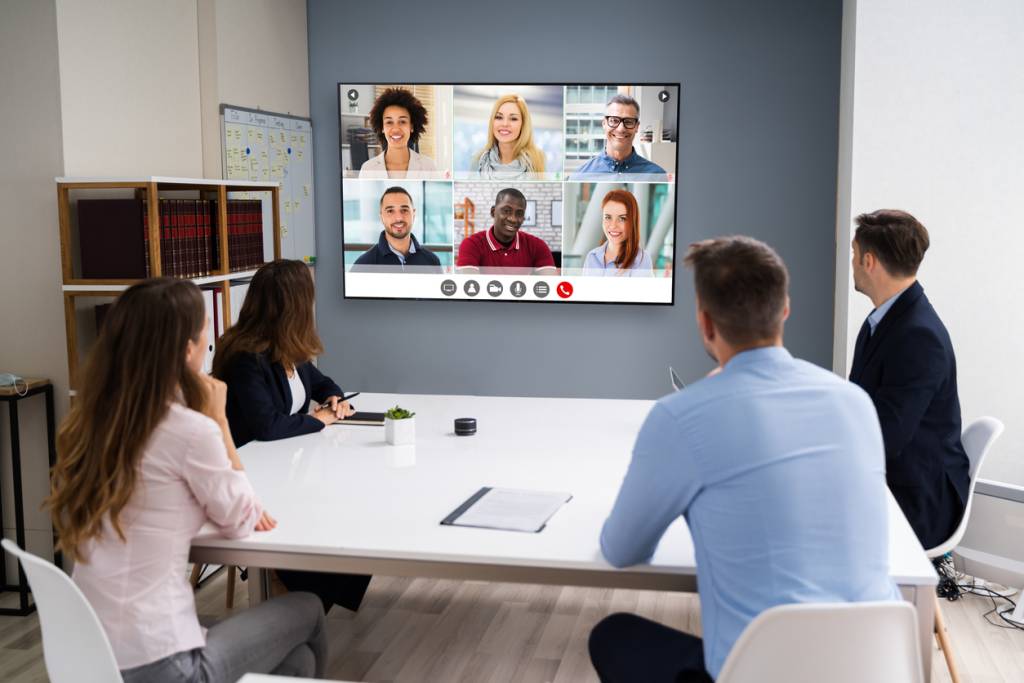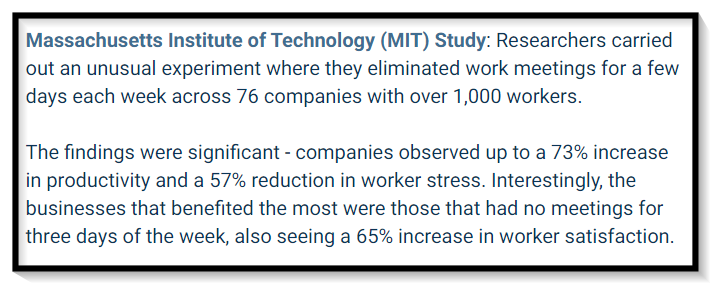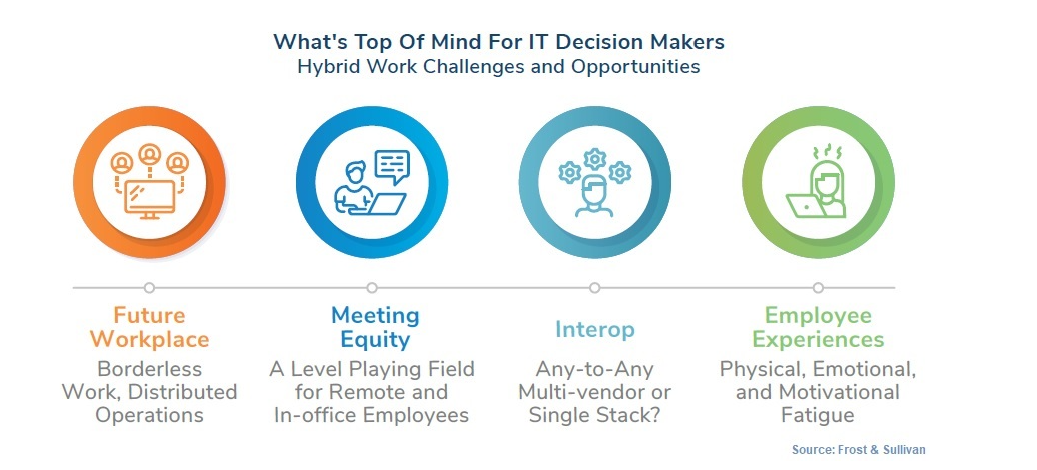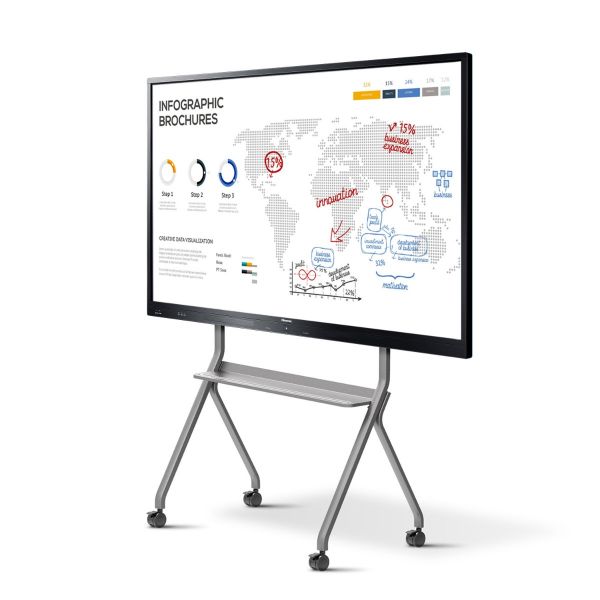The modern workplace has come a long way since the days of 9 to 5, when turning up at the office was the only way to imagine things getting done.
Hybrid working has helped to dispel the argument that being present is the same as being productive, and with the innovative conference room technology available today, meeting spaces have evolved beyond recognition.
Optimal productivity, effective communication and efficient time management are the goals of every organization. To achieve this, understanding the average time spent in meetings is essential. Meetings can either enhance collaboration, or become an unproductive potential time drain if not managed properly.
It's estimated that managers in any organization spend 35% - 50% of their time in meetings, yet a good proportion of this time ends up being unproductive.
Download a PDF of A Comprehensive Guide to Device Management

Download a PDF of A Comprehensive Guide to Device Management
What's intended to be an efficient way for people to come together, discuss ideas, drive outcomes, troubleshoot and brainstorm, often becomes a waste of valuable time, with ideas quickly disappearing into the ether and no outcome at all.
So how do organizations overcome this lack of positive outcome and boost productivity in the conference room - and in the workplace in general?
In this guide, we'll explore how properly deployed and managed conference room technologies can make the difference between people wasting time in meeting rooms, and virtual meetings that become creative, productive hubs.

The anatomy of a bad meeting
Meetings interrupt productive work, and when run poorly, meetings can drain people’s energy. At the same time, meetings can also give people the information they need to keep work productive and motivational, driving decisions and mutual accountability. So how do organizations find the balance?
As mentioned, much of the time spent in the meeting room is wasted, and executives view more than 67% of meetings as non-productive. Technical issues with conference room equipment and conference room setup can impact productivity by causing delays and throwing discussions off-course.
Issues like double-booked meeting rooms, lack of adequate space, incompatible video conferencing equipment and poor, unstable internet connections are disruptive and costly.
In the United States, businesses collectively lose an estimated $37 billion annually due to unnecessary meetings.
This figure represents both time misspent, and a significant loss in productivity and allocation of resources. To put this in perspective, unproductive meetings equate to almost 300,000 hours of work every year, which is an incredible amount of potential output lost.
This scenario highlights the need for organizations to re-evaluate their meeting strategies and consider more effective approaches to time management to mitigate these substantial losses.
The case study below illustrates this further:

Image source: Flowtrace
Conference room equipment: An engine room of productivity
If meetings are a vehicle of productivity in the workplace, then it's the conference room equipment within your meeting room that is the engine.
There are several ways to make meetings more productive, and the right conference room technology can turn meeting spaces into a productive and collaborative environment, for in person attendees at a physical location as well as for remote participants
Adopting the latest conference room tech begins with first taking stock of legacy equipment and applications. Is it the right technology for the number and types of meetings expected each week? Are they user-friendly, enterprise-grade solutions that can integrate with both remote and hybrid work?
A smart meeting room can help eliminate the logistical challenges of running meetings, so let's look more closely at the factors that can cause meetings to be unproductive in the first place, and the latest conference room technology trends that are helping fix the problems.

Outdated conference room equipment
Organizations need to consider the time cost of outdated conference room technology. A secure and reliable network, up to date technology, ease-of-collaboration and efficient booking methods all contribute to smooth communication and the success of each meeting in your office.
Faulty video conferencing technology like glitchy audio and wireless presentation systems or conference room display equipment that doesn't work as it should, can severely impact an organization's progress. Well-equipped meeting rooms contain such advanced features and equipment as:
-
Ceiling mounted microphones
-
Wireless screen sharing
-
High definition cameras
-
Interactive displays
-
Flexible furniture

Updating the technology in meeting rooms should not only be a priority, but an ongoing endeavor for enhanced collaboration.
Reduced collaboration equity
Collaboration equity is a relatively new addition to the workplace vernacular that's used to describe the extent to which a team can communicate and contribute equally within meeting spaces, no matter where they are or whether it's from personal devices or static office equipment.
True collaboration equity allows remote workers to access all the meeting room technology necessary to do their jobs from home, whether that's to take part in a video conference, screen sharing, use mobile devices, access a digital whiteboard, or communicate separately with other meeting participants in real time. Outdated legacy systems often prohibit collaboration equity.
For example, team members in different time zones may not be able to attend every meeting, so a valuable piece of conference room equipment could be to have access to a meeting recording feature and/or transcripts so that those teammates can catch up on what they missed on their own time.

Incompatibility with new technologies
Many legacy conference room systems are not 100% compatible with contemporary meeting room technology like smartphones and tablets. Some equipment also requires the use of specific operating systems for full functionality.
This could mean that when trying to make a call, your device may not be compatible with the one you’re trying to reach.
In the hybrid workplace, vendor-locked systems may not be suitable to provide the flexibility required to sustain remote working models. In today's meeting environments, Bring Your Own Device (BYOD) and Bring Your Own Meeting (BYOM) solutions are the technologies being purchased/sold most, to help employees collaborate seamlessly in the office and at home, no matter what platforms are being used.
How video conferences can improve meeting effectiveness
The only way for modern and innovative businesses to grow and globalize is to build and maintain quality relationships with partners, suppliers, internal teams, investors and customers.
Traditionally, this was a costly and time-consuming undertaking, requiring extensive travel to attend meetings, and often impacting the productivity of management level staff.
During the pandemic of course, travel was not possible, so to maintain business continuity and preserve relationships, video conferencing became the new normal for meetings. Instead of corporate boardrooms, home offices became global meeting rooms and thanks to constantly evolving conference room technology, businesses could carry on.
Video conferencing tech has enabled the success of the hybrid workplace model by boosting productivity, saving time, reducing travel expenses, and promoting collaboration.
The role of management in efficient meetings
A well-conducted meeting hinges significantly on structure and management. Agendas should take center stage when it comes to effective meetings, yet surprisingly, only 37% of workplace meetings actively utilize them. Agendas play a crucial role in keeping discussions on track, keeping the relevant participants engaged, and ensuring that meetings are purposeful and time-efficient.
Some agendas will set out how much time should be spent on each topic to encourage employees to remain focused.
For those leading the meeting, agendas help them plan the way information and feedback will be administered. If participants have ideas before the meeting, sending out your agenda before the meeting can serve as a good reminder.
Consider including the following elements in your meeting agenda:
-
A short description of the primary objective of the meeting
-
A summary of the topics that will be covered
-
A list of the meeting participants
-
Which participants will be addressing specific topics
-
Meeting time and location
-
Estimated meeting length
-
Any relevant background information about the topics and objectives
Meeting managers are responsible for ensuring that every participant understands the general flow of the meeting, so that they'll be more likely to stay on track if the discussion strays from the main goal.
Best Practices for Efficient Meeting Management
As we've established, efficient meeting management is essential to cut costs and enhance productivity. Here are some best practices:
Clear agenda planning: Set a clear, concise agenda for each meeting and for remote participants as well as in-office staff. This helps in keeping discussions focused and time-bound, reducing the likelihood of overruns that can escalate costs.
Strict time management: Be firm about the time schedule for meetings. Starting and ending on time respects the schedules of other participants, and curtails unnecessary time expenditure.
Selective participation: As part of a meeting agenda, ensuring that only key stakeholders are in attendance helps to minimize the indirect costs associated with pulling numerous employees away from their core tasks.
Regular review of meeting practices: Periodically review meeting practices and solicit feedback from as many participants as possible. This helps to identify inefficiencies and areas for cost reduction.
Getting conference room technology right
Productive meetings come from the marriage between quality technology and well planned, consistent meeting habits, including planning as mentioned above.
Video conferencing technology has been a key enabling factor in improving business relationships and reducing the time required to complete projects.
For hybrid meetings to work effectively, technology and IT systems should allow employees to communicate and collaborate on projects interchangeably, whilst working in different locations and on different devices. This can only happen if there are solutions to enable it.
Conference room technology should allow users to call, conference, text, and share files all from any device. If conference rooms are correctly set up with the right equipment, remote participants should feel as though they are physically in the same room with those in a fixed location. Here are some of the most important elements of an efficient meeting room, and how these elements enhance productivity.
Digital whiteboard
Digital whiteboards are common conference room technologies, and important for content sharing, collaborating creatively and brainstorming. Interactive digital whiteboards allow meeting participants to deliver presentations, share annotations, documents, photos, and interact with others across devices during hybrid meetings.
Wireless presentation system
Conference room technology should not only support meetings, but empower people, and provide a better work experience. Wireless technology allows multiple presenters to easily share information with no time wasted when switching between presenters. It also enables collaboration on a project, or allows a presenter control of the information from their own device. Systems can also be moved between conference rooms and many have a range of additional features depending on the best solution for the meeting.
Quality display screen
Displays are an important element of conference room equipment, and your screen is one of your main collaboration tools. In a video meeting, a quality display screen enables you to see colleagues in other locations, view presentations, and screen-share from laptops, tablets and smartphones.
Companies like Samsung, Sharp, and NEC have all developed state-of-the-art displays to fit a variety of needs. The high pixel density of a 4K screen can provide capabilities for various applications in conference rooms. High-quality detailed imaging and walk-throughs, increased visibility for everyone in the room under varying ambient lighting conditions, thanks to brightness and contrast levels, and more. The higher the quality of the screen, the more interactive displays and will be.
But be aware that bandwidth and content can all impact image quality, so a good WiFi connection and sufficient bandwidth are all important for effective collaboration.
The word multitask was adopted as business jargon to describe modern work habits. While the verb is perfectly apt for computers, where CPUs can execute multiple processes concurrently, it is less apt for people.
Neurologically, humans cannot do more than one thing at a time effectively, and attempting to do so can negatively affect productivity. Video meetings can help distributed teams share ideas,and encourage productivity by using interactive displays to return the focal point to those in the conference room in real time.

Conference room scheduling software
Robust, user-friendly conference room scheduling software helps to streamline and simplify the process of reserving meeting space in conference rooms. This saves time reduces double-bookings and other scheduling errors as well as updating participants if there are any changes to the meeting time, location or agenda. Keeping people on schedule allows them to do their best work with minimal interruption.

Control panel
A control panel is important to conference room design and video conferencing success, as it acts as your control center for the whole conference room audio visual system.
The user interface on the control panel is critical. It should be easy for users to get in the conference room and connect to video calls or launch presentations and allow transition from a screen-sharing presentation to video conferencing, all with a single touch.
Good sound quality
High quality microphones and speakers are an important consideration for effective collaboration, particularly in a large conference room.
High quality microphones and speakers can help make more productive meetings and enhance productivity and the overall conferencing experience. The right setup can reduce echo, feedback and other noises for conference participants.

Wireless screen sharing tools
Meeting attendees need to be able to walk into a meeting room and be able to share their content to the screen seamlessly and without too much effort.
HDMI cables can become damaged or missing, and this results in meetings being too often held up by technical difficulties when it comes to screen sharing.
With wireless screen sharing tools, anyone can present content to the front of the room from any device without adaptors or cables needed.
Monitoring and troubleshooting your conference room technology with IR
Collaboration spaces are essential components of modern workplaces, with hybrid ways of working increasing the need for more flexible collaborative spaces outside the typical meeting and conference room.
IR's Collaboration Space Management solution enables proactive monitoring and remote management of all conferencing-enabled collaboration spaces from a single vantage point. This includes all collaboration platforms, equipment and devices, to create a seamless, cohesive collaboration experience for users.
Proactive monitoring and management are essential to ensure Quality of Service (QoS), and optimize user experience. Without monitoring, organizations are essentially 'flying blind' with their entire UC environment.
The failure of just one component of your communication equipment can lead to poor quality connection and downtime, as well as a bad experience for users, which directly impacts your bottom line. Here's what our Collaboration Space Management solution can offer:
Remote UC & End-Point Management
-
Control, configure and test UC platforms and video communication devices
-
Remotely conduct software/firmware updates
-
Automate space readiness for users
Monitoring of Collaboration Spaces
-
Advanced monitoring, alerting and troubleshooting of video communication devices and UC tool issues.
-
Actionable, intelligent insights into space usage, and voice and video quality.
Multi-vendor, Multi-technology Visibility
-
Support for all UCaaS Rooms platforms including Microsoft Teams Rooms, Zoom Rooms, Webex Rooms.
-
Support for all device manufacturers including Jabra, Poly, Logitech, and many more.
You can improve your organization's productivity and maximize meeting time by ensuring that the technology in your collaboration space is always meeting-ready.
Efficiency and scalability are enhanced by leveraging automation and remote management to reduce manual processes and overcome physical access limitations when supporting users and devices.
And with IR Collaboration Space Management, you can see clearly when tools in your collaboration spaces are being used, giving you the means to support and manage them effectively
Download a PDF of A Comprehensive Guide to Device Management

Download a PDF of A Comprehensive Guide to Device Management




